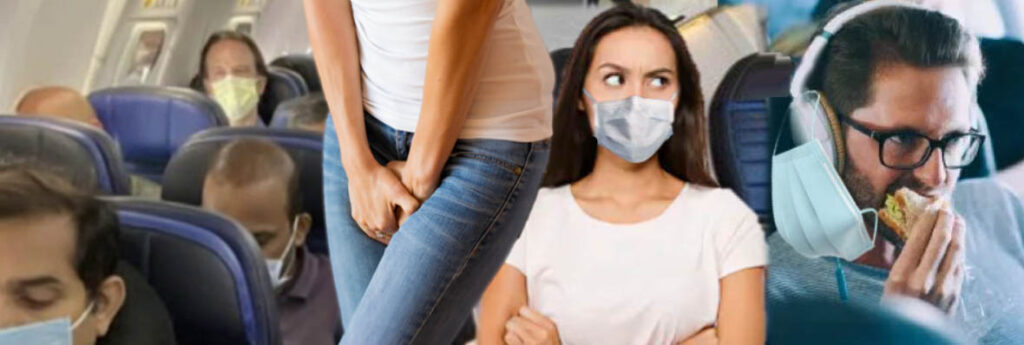Isn’t this just the plan to bring passengers surging back onto airplanes. Limit food and drink – or suspend service completely on short haul flights – no queuing up for toilets, but if you really have to use the facilities you could need the permission of the crew. “But please Miss, I have to go – now!” Face masks, necessary of course, but social distancing curiously, “only when occupancy allows it.”
Hand luggage should be limited to a small bag per passenger, which can be stowed under the seat, and newspapers and magazines should be removed.
The new International Civil Aviation Organization (ICAO) guidelines are designed to protect air passengers and workers from the Covid-19 virus as lockdown eases.
Isn’t that onsiderate of them?
There just seems to be one little fly in the ointment – we are told repeatedly that the best way to avoid either passing on the virus – or getting it ourselves is to social distance.
But fewer available seats would affect occupancy rates and the bottom line. And fewer snacks, meals and drinks, to say nothing of less luggage (which is also recommended), wouldn’t begin to make up the difference. Though there is that story about American Airlines famously saving US$40,000 a year by removing one olive from each salad in first class.
Anyway, ICAO which is a UN organization, suggests short-haul food and drinks services should be limited or suspended, or be sold in sealed, pre-packaged containers. Could you bring your own drinks/snacks?
No magazines or newspapers provided – not clear whether you can bring your own – and what about a laptop or other electronic devices?
Access to toilets should also be restricted, the ICAO said. Where possible, one toilet should be set aside for use by cabin crew and passengers should use a designated lavatory based on which seat they have.
Face masks should be worn in line with public health guidelines, and social distancing should be made possible where it is feasible. (Our italics)
There is an upside: passengers are told to “limit interaction on board” – so the chatty neighbour can be politely ignored. Just point at your mask and give a little cough. Of course, when you remove it to eat your snack (should you get one) you may cause some consternation.
Areas they say, should be routinely cleaned, and passengers checked for signs of coronavirus, by screening temperatures, for example (presumably prior to boarding). Contact tracing methods should also be explored.
The onboard washroom protocol intrigues me. Do you have to raise your hand and ask, or push your call button, do you get a number, and is the loo one of the “routinely cleaned” areas? Are they cleaned between passenger visits? I don’t see flight attendants going along with this, but we all know these little closet-like spaces on planes are Petri dishes of bacteria – there is nothing you can avoid touching and everything you touch is … well … never mind …
At airports, the ICAO says, staff should have adequate personal protective equipment, which “could include gloves, medical masks, goggles or a face shield, and gowns or aprons.”
Passengers should be encouraged to check-in before getting to the airport, and to use mobile boarding passes.
Airports should also use contactless technology, including facial and iris scanning, for “self-service bag drops, various queue access, boarding gates and retail and duty-free outlets”, the guidelines say.
“This will eliminate or greatly reduce the need for contact with travel documents between staff and passengers.”
At the airport human contact will be limited, social distancing the norm (till you board the aircraft when it becomes a ‘maybe’). Masks will be obligatory, and supplies of hand sanitiser should be readily available.
If you’re one of those types who balk at technology – suck it up – or drive. ICAO suggests that “contactless biometrics such as facial or iris recognition ” should be used wherever possible, to reduce physical contact between staff and passengers.
ICAO claims the new measures should be temporary, and says it is creating a consistent framework for the industry to follow around the world – allowing people to travel, while placating even the strictest health authorities.
The strictest health authorities? Really? The health authorities – not the airlines?
We all understand what a catastrophic time this is for carriers. We know the huge losses they have incurred. However, if you want to get bums on seats in any major way once again – people are going to have to feel safe. And yes, certainly some will fly, regardless how cramped in they are, we know that. Especially certain demographics. -millennials will likely fly regardless, boomers will be more restrained. Business travellers are likely to be an entirely different story – one we will watch closely.
It’s a given that we all want to travel again… and we all will travel again. But if a wave of COVID-19 breaks out after a flight, we run the risk of scaring people away yet again and seeing quarantines come slamming down once more. Why not in these early days actually mandate social distancing on board. In the long run it may be the most economical thing to do.

